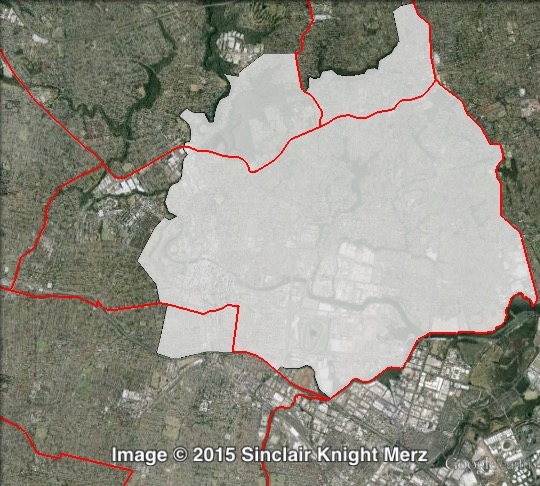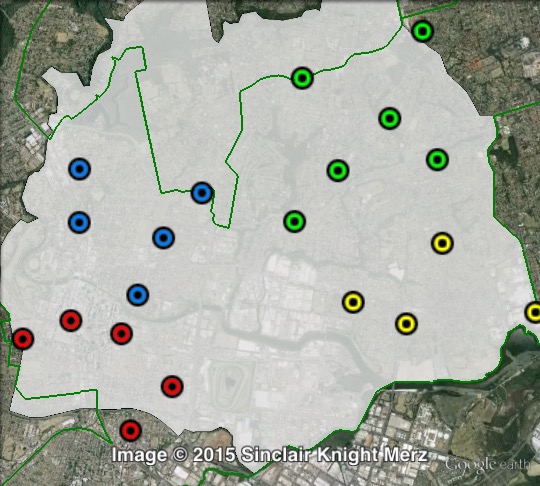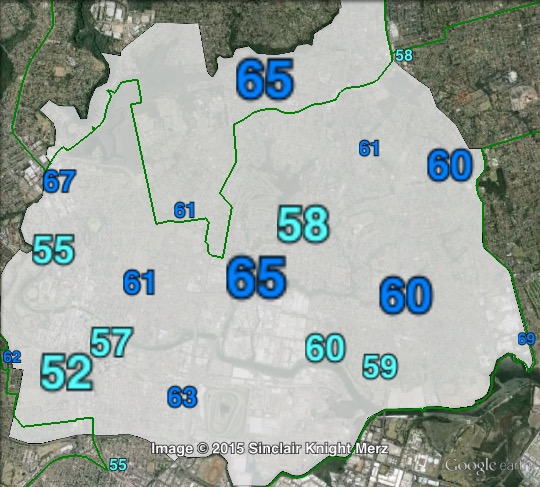LIB 12.5%
Incumbent MP
Geoff Lee, since 2011.
Geography
Western Sydney. Parramatta covers suburbs around the Parramatta CBD, including Carlingford, Dundas, Ermington, Harris Park, Rydalmere and parts of North Rocks. It covers a large proportion of the City of Parramatta and small parts of the City of Holroyd and the Hills Shire.

Redistribution
Parramatta lost Westmead and Wentworthville to Seven Hills, gained Harris Park from Granville, gained parts of North Rocks from Baulkham Hills and gained Carlingford from Castle Hill. These changes increased the Liberal margin from 12.1% to 12.5%.
History
The electoral district of Parramatta has existed continuously since the first Legislative Assembly in 1856. The seat was first a two-member district until 1880, when it became a single-member district. It expanded in 1920 to become a three-member district, before becoming a single-member district in 1927. The seat was dominated by conservative parties in the early 20th century, but since the 1950s it has been dominated by the ALP, who have won all elections except for the 1956, 1988 and 2011 elections.
Parramatta was won in a 1916 by-election by Liberal candidate Albert Bruntnell. Over the previous decade he had twice served in the Legislative Assembly, representing Surry Hills and Annandale. He served as Member for Parramatta continuously until his death in 1929. When Parramatta expanded in 1920 it took over the previous seat of Granville, and the former Member for Granville, Jack Lang, was elected as a member for Parramatta. He twice served as Premier, and when single-member districts were restored in 1927, he was elected in Auburn.
The 1929 by-election was won by senior military officer Herbert Lloyd, running as a Nationalist. He lost in 1930, but later held Mosman from 1932 to 1941.
Parramatta was won in 1930 by the ALP’s Joseph Byrne. He held the seat until 1932, when an election was triggered by the Governor’s removal of Lang as Premier. Byrne was one of many casualties of the ensuing landslide.
George Gollan won Parramatta in 1932 for the United Australia Party. He served as a minister in UAP governments from 1938 to 1941. He held the seat until the 1953 election, when a redistribution made the seat stronger for the ALP. He retired and was succeeded by the ALP’s Kevin Morgan.
Morgan held the seat for one term, losing in 1956 to Jim Clough of the Liberal Party. Clough himself lost in 1959. He later held the seat of Eastwood from 1965 to 1988. He served as a minister for the final four months of the Liberal government in 1976.
Parramatta was won in 1959 by the ALP’s Dan Mahoney. He held the seat until his retirement in 1976. Barry Wilde, also of the ALP, held the seat from 1976 to 1988.
The Liberal Party’s John Books won Parramatta in 1988 by 268 votes. In 1991, the redistribution made the seat notionally Labor, and Books lost to the ALP’s Andrew Ziolkowski.
Ziolkowski was diagnosed with cancer of the oesophagus in 1993, and died in 1994. The ensuing by-election was won by his wife Gabrielle Harrison. Harrison served as Minister for Sport and Recreation in the first term of the Carr government from 1995 to 1999.
Prior to the 2003 election, Harrison faced a preselection challenge from Tanya Gadiel, an advisor to Police Minister Michael Costa. In the face of the challenge she stepped down, and Gadiel won the seat in 2003.
Gadiel was re-elected in 2007 and became a parliamentary secretary shortly after. She left that post in 2008 to serve as Deputy Speaker of the Legislative Assembly, and she retired in 2011.
Liberal candidate Geoff Lee won Parramatta at the 2011 election.
Candidates
- Joanne Kuniansky (Independent)
- Frank Arduca (No Land Tax)
- Geoff Lee (Liberal)
- Kamal Boutros (Christian Democratic Party)
- Phil Bradley (Greens)
- James Shaw (Labor)
- Michelle Garrard (Independent)
Assessment
Parramatta is a key marginal seat. While Labor is in a strong position to win back many seats lost in 2011, Parramatta may be too far for Labor.
2011 election result
| Candidate | Party | Votes | % | Swing | Redist |
| Geoff Lee | Liberal | 21,673 | 48.4 | +19.6 | 48.3 |
| Pierre Esber | Labor | 12,425 | 27.7 | -23.6 | 27.9 |
| Phil Bradley | Greens | 3,806 | 8.5 | +1.8 | 8.7 |
| Michael McDermott | Independent | 3,282 | 7.3 | +7.3 | 6.3 |
| Peter Magee | Christian Democrats | 1,674 | 3.7 | -1.7 | 4.0 |
| Duncan Roden | Socialist Alliance | 706 | 1.6 | +1.6 | 1.2 |
| Thomas Katsoulas | Family First | 622 | 1.4 | +1.4 | 1.3 |
| Kon Paraskevopoulos | Independent | 438 | 1.0 | +1.0 | 0.8 |
| Robert Aiken | Communist League | 152 | 0.3 | +0.3 | 0.3 |
| Others | 1.2 |
2011 two-party-preferred result
| Candidate | Party | Votes | % | Swing | Redist |
| Geoff Lee | Liberal | 23,669 | 62.1 | +25.8 | 62.5 |
| Pierre Esber | Labor | 14,464 | 37.9 | -25.8 | 37.5 |

Booth breakdown
Booths in Parramatta have been split into four parts: east, north-east, south-west, and west.
The Liberal Party won a majority of the two-party-preferred vote in all four areas, ranging from 57.3% in the south-west to 62% in the north-east.
The Greens vote ranged from 7.4% in the east to 8.7% in the south-west. Independent candidate Michael McDermott’s vote ranged from 4.5% in the south-west to 10.5% in the north-east.
| Voter group | LIB 2PP % | GRN % | IND % | Total votes | % of votes |
| North-East | 62.0 | 8.6 | 10.5 | 10,048 | 22.8 |
| West | 59.9 | 8.8 | 5.1 | 7,048 | 16.0 |
| East | 60.7 | 7.4 | 8.8 | 5,737 | 13.0 |
| South-West | 57.3 | 8.7 | 4.5 | 4,687 | 10.6 |
| Other votes | 64.7 | 9.2 | 3.9 | 16,517 | 37.5 |



Very much looking forward to see what the outcome will be here. Could be extremely close. The redistribution has moved the seat into areas I generally would not associate with Parramatta; the suburb of Parramatta itself is in the south-west corner of the district. Suburbs like Ermington, Rydalmere, and Dundas I would more associate with Epping and Ryde.
Both state and federal Parramatta have always been oddly shapeless seats. Because Parramatta town sits on the border between the Great Labor West and the Great Liberal North, the electorate can be part of either, depending on where its boundaries are at any given time. At the moment its more North than West, and I don’t think there’s enough West in it to make it a likely prospect for Labor this time.
Parramatta has been shoved back and forth a lot at the last few federal redistributions, if I remember correctly Parramatta central was only at the very edge of the seat a few years back. Anyway, I tend to think Lee has enough of a margin to people returned
I meant be instead of people there, bloody phone autocorrect
There was a particularly large swing last time, so I’d expect an above-average correction. Perhaps an outlier on election night.
This seat will probably tell whether Labor can achieve the impossible and take government back. This is the last seat they need to capture before being in minority government territory under a uniform swing.
Driving around the Rydalmere area, iv seen a lot more Geoff Lee signs up than Labor signs.
My prediction: Made better in the redistribution, this one will probably narrowly stay Liberal.
Labour just didn’t spend the money campaigning for james shaw as the blue army. Parramatta looked vandalized with Geoff heads.